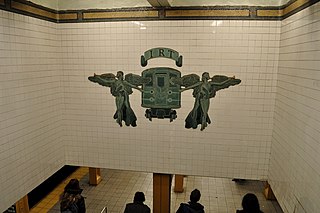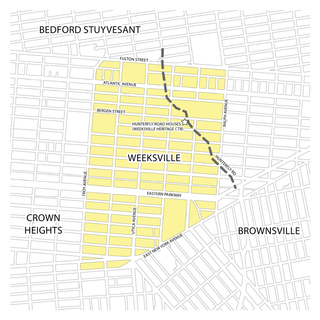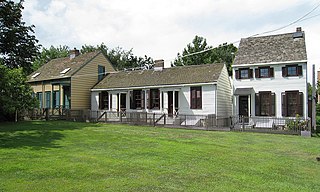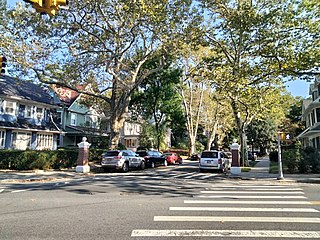
Brooklyn Botanic Garden (BBG) is a botanical garden in the borough of Brooklyn in New York City. The botanical garden occupies 52-acre (21 ha) in central Brooklyn, close to Mount Prospect Park, Prospect Park, and the Brooklyn Museum. Designed by the Olmsted Brothers, BBG holds over 14,000 taxa of plants and has over 800,000 visitors each year. It includes a number of specialty gardens, plant collections, and structures. BBG hosts numerous educational programs, plant-science and conservation, and community horticulture initiatives, in addition to a herbarium collection and a horticulture and botany library.

Prospect Park is an urban park in Brooklyn, New York City. The park is situated between the neighborhoods of Park Slope, Prospect Heights, Prospect Lefferts Gardens, Flatbush, and Windsor Terrace, and is adjacent to the Brooklyn Museum, Grand Army Plaza, and the Brooklyn Botanic Garden. With an area of 526 acres (213 ha), Prospect Park is the second largest public park in Brooklyn, behind Marine Park. Designated as a New York City scenic landmark and listed on the National Register of Historic Places, Prospect Park is operated by the Prospect Park Alliance and NYC Parks.

Flatbush is a neighborhood in the New York City borough of Brooklyn. The neighborhood consists of several subsections in central Brooklyn and is generally bounded by Prospect Park to the north, East Flatbush to the east, Midwood to the south, and Kensington and Parkville to the west. The neighborhood had a population of 105,804 as of the 2010 United States Census. The modern neighborhood includes or borders several institutions of note, including Brooklyn College.

The Grand Army Plaza station is a local station on the IRT Eastern Parkway Line of the New York City Subway. It is located in Park Slope, Brooklyn, underneath Flatbush Avenue at its intersection with Plaza Street West and St. Johns Place, on the northwest side of Grand Army Plaza. It is served by the 2 train at all times, the 3 train at all times except late nights, and the 4 train during late nights.

The Prospect Park Zoo is a 12-acre (4.9 ha) zoo located off Flatbush Avenue on the eastern side of Prospect Park, Brooklyn, New York City. As of 2016, the zoo houses 864 animals representing about 176 species, and as of 2007, it averages 300,000 visitors annually. The Prospect Park Zoo is operated by the Wildlife Conservation Society (WCS). In conjunction with the Prospect Park Zoo's operations, the WCS offers children's educational programs, is engaged in restoration of endangered species populations, runs a wildlife theater, and reaches out to the local community through volunteer programs.

The BMT Franklin Avenue Line is a rapid transit line of the New York City Subway in Brooklyn, New York, running between Franklin Avenue and Prospect Park. Service is full-time, and provided by the Franklin Avenue Shuttle. The line serves the neighborhoods of Bedford-Stuyvesant and Crown Heights, and allows for easy connections between the Fulton Street Line and the Brighton Line.

The Prospect Park station is an express station on the BMT Brighton Line of the New York City Subway. It is located in between Lincoln Road, Lefferts Avenue, Empire Boulevard, Ocean Avenue and Flatbush Avenue in Flatbush, Brooklyn, near the border of Crown Heights, Prospect Heights, Park Slope, and Prospect Lefferts Gardens. The station, which serves Prospect Park and Brooklyn Botanic Garden, is served by the Q train and Franklin Avenue Shuttle at all times and by the B train on weekdays.

The Seventh Avenue station is a station on the BMT Brighton Line of the New York City Subway, located at the intersection of Seventh Avenue, Park Place and Flatbush Avenue in Park Slope and Prospect Heights, Brooklyn. The station is served by the Q train at all times and by the B train on weekdays only.

Weeksville is a historic neighborhood founded by free African Americans in what is now Brooklyn, New York, United States. Today it is part of the present-day neighborhood of Crown Heights.

The Weeksville Heritage Center is a historic site on Buffalo Avenue between St. Marks Avenue and Bergen Street in Crown Heights, Brooklyn, New York City. It is dedicated to the preservation of Weeksville, one of America's first free black communities during the 19th century. Within this community, the residents established schools, churches and benevolent associations and were active in the abolitionist movement. Weeksville is a historic settlement of national significance and one of the few remaining historical sites of pre-Civil War African-American communities.

Eastern Parkway is a major road that runs through a portion of the New York City borough of Brooklyn. Designed by Frederick Law Olmsted and Calvert Vaux, it was the world's first parkway, having been built between 1870 and 1874. At the time of its construction, Eastern Parkway went to the eastern edge of Brooklyn, hence its name.

Prospect Lefferts Gardens is a residential neighborhood in the Flatbush area of the New York City borough of Brooklyn. The community is bounded by Empire Boulevard to the north, Clarkson Avenue to the south, New York Avenue to the east, and Ocean Avenue/Prospect Park to the west. Prospect Lefferts Gardens was designated a New York City Landmark area in 1979 and called the Prospect Lefferts Gardens Historic District.

The Wyckoff-Bennett Homestead in Flatlands, Brooklyn, New York City, is a National Historic Landmark. It is believed to have been built before 1766. During the American Revolution it housed Hessian soldiers, two of whom, Captain Toepfer of the Ditfourth regiment and Lieut. M. Bach of the Hessen-Hanau Artillerie, scratched their names and units into windowpanes. It was declared a National Historic Landmark in 1976. It is part of the New York State Revolutionary War Heritage Trail.

The 14th Regiment Armory, also known as the Eighth Avenue Armory and the Park Slope Armory, is a historic National Guard armory building located on Eighth Avenue between 14th and 15th Streets in the South Slope neighborhood of Brooklyn, New York City, United States. The building is a brick and stone castle-like structure, and designed to be reminiscent of medieval military structures in Europe. It was built in 1891–95 and was designed in the Late Victorian style by William A. Mundell.
Central Brooklyn consists of several neighborhoods often grouped together because of their large populations of African Americans and Caribbean Americans. Central Brooklyn is the largest collection of black communities in both New York City and the United States. These neighborhoods include:

West Midwood is a planned community and historic enclave in the New York City borough of Brooklyn. West Midwood is located in central Brooklyn in the southern edge of the community of Victorian Flatbush, abutting the northern boundary of the community of Midwood. It is bordered by Foster Avenue to the north, the BMT Brighton subway line to the east, Avenue H to the south, and Coney Island Avenue to the west. West Midwood is located south of Prospect Park within what is sometimes referred to as Ditmas Park.

Battle Pass, formerly known as Flatbush Pass or Valley Grove or The Porte, is a historic hill pass that played a significant part in the 1776 Battle of Long Island, and that is currently part of Prospect Park in Brooklyn.

The Flatbush African Burial Ground or FABG is the site of a historic African-American cemetery dating to the 17th century at Church and Bedford Avenue in Brooklyn, on land formerly owned by the adjacent Flatbush Reformed Dutch Church.




















